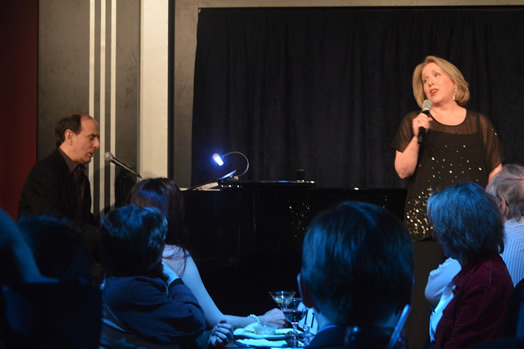Allegro
‘How do you write a song?’
Member to Member
Volume 117, No. 11November, 2017
Allegro’s “Member to Member” column invites musicians to submit their own personal thoughts on music. We’ve recently received essays from members who are also songwriters. Below, Local 802 member Robert Grusecki and his creative partner and wife Anya Turner discuss their take on the songwriting process. The two were recently honored with Backstage’s 2017 Bistro Award for excellence in songwriting. The judges recognized their successful career writing and performing an impressive catalogue of freshly original material – enough to fill three songbooks, five CDs and two Off Broadway shows. Their web site is www.anyarobertmusic.com.

Husband and wife team Robert Grusecki and Anya Turner.
There is a song on our recent recording that describes our creative process. It’s called “How Do You Write A Song” and the lyrics begin:
How do you write a song
You hum, you pace, you moan, you mutter
You laugh, you cry, you curse and sputter
‘Til it’s done
It’s fun
We are singer-songwriters with a musical theatre background and, although we have written two “book musicals” (“After All” and “Greetings From Yorkville”), more often than not we write stand-alone songs. We use our own life experiences and observations about the world around us as our source material. When people ask us, “Which do you write first, the music or the lyrics?” we always say, “Yes.” But seriously, what comes first is the feeling. Then we write the song that we hope will make someone else experience that feeling.
Where do you write a song
The bed, the chair, the couch, the toilet
Who cares as long as you don’t spoil it
And the thought
Gets caught
Since we are married, a lot of our work takes place around the kitchen table or at the piano in our fifth-floor walkup. But an equal amount of work happens just walking around the city. There is something about a body in motion that can suggest tempo, meter, rhythm and rhyme. And to some degree distractions are welcome. That way the muse doesn’t feel overly scrutinized. More on that later…
You find a family of words
With some repeating
But none competing
You weave the music and the words
With deep expression
And much compression
They learn to get along
Craft and form are important to us. When Robert first auditioned for Lehman Engel at the BMI Musical Theatre Workshop, Mr. Engel said two things: “You’re in. Now let’s talk about true rhymes vs. pop rhymes.” That was a big lesson. We write in traditional song forms, usually AABA or ABAB (often with an introductory verse), and we take the occasional excursion into a through-composed piece. We will use the verse/chorus form as long as the repeated chorus furthers the dramatic action of the song. Since we are working with a limited amount of real estate, speaking volumes with a few words is key: That’s compression. And the lyric is often a cover for the emotional truth that is being carried more directly in the music: That’s expression. Add to this the intricacies of harmony, rhyme schemes, musical textures, style, and intent and you are almost there.
When do you write a song
Today, tonight, or when requested
It’s worth the time and what’s invested
Is your heart
Just start
Many things can inspire a song. We collect expressions and ideas and store them away for later use. It can be a word (“Mirage”), a phrase (“If You See Something, Say Something”), an incident (“Pedicab Guy”), a memory (“Iowa Summer”), a friend (“Two Girls”), a relative (“Paul”), a book (“Harper Lee”), or an overheard conversation (“A Golden Age”). Deadlines are also good. Songs commissioned for special occasions (“Fifty Is The New Twenty-five”) or shows that need an opening number (“Look Up!”) are great motivators. But it all starts with giving yourself permission to make songwriting a priority. Inspiration comes and goes; it’s the commitment that sustains you.
Your songs are children in the world
You love and nourish
And hope they flourish
They make their way around the world
And if they’re lucky
And oh so plucky
They find a way to fly
Fly
We don’t have kids, a car, or a house. Our songs are at the center of our lives. We take them with us wherever we go and share them with as many other artists as possible. Our songs have been heard in nightclubs, cabarets, theatres, and concert halls all over the world and they have been performed by such artists as Karen Akers (“Ordinary People”), Donna McKechnie (“Cell Phone” and “Life Is Good”), and Steve Ross (“Handle Me With Care”). After copyrighting our songs and registering them with ASCAP, we try to maintain a healthy balance between being out there in the world promoting our music and protecting the quiet inner life necessary to continue to write. Staying fresh creatively is essential. Our goal always is to try something new. We are currently recording an intimate piano/vocal album of 15 new songs and stories. The new twist this time is, a filmmaker is filming our sessions as the basis for a documentary he is making about us and our work.
Why do you write a song
Why not?
Because it makes me happy
I need a place that’s warm and sappy
To go on
For now
How do you write
Oh, how do you write a song
And those are only a few of the many elements that go into writing a song. Songwriting is not for the faint of heart, nor is any other artistic endeavor. In the words of Anya’s acting teacher, Michael Shurtleff, “If you can think of anything else you might be happy doing, do that.” So, follow your muse. You write because you have to. It is your joy, your refuge, and your life.
To submit an essay for consideration in Allegro’s “Member to Member” column, send an e-mail to Allegro.
